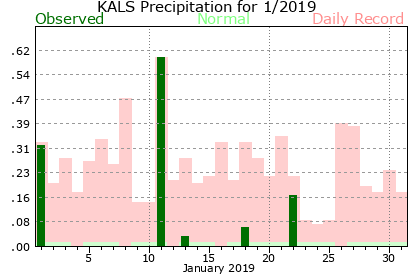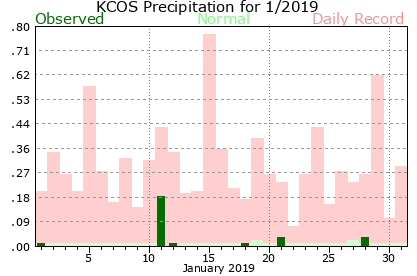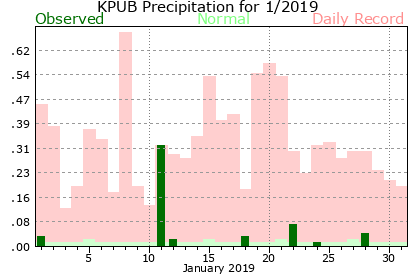January of 2019 started out cold and unsettled, as a passing weather system ushered in some of the coldest air of the season across the area on New Years Day. The rest of January can be characterized by periodic weather disturbances moving through persistent moderate west to northwest flow aloft across the Rockies. This pattern brought beneficial snowfall to areas over and near the higher terrain, with periods of warm temperatures and strong winds, as well as brief periods of moisture and cold temperatures, to the Southeast Plains. For the month of January as a whole, near normal to below normal temperatures and above normal precipitation was experienced for areas over and near the higher terrain, with generally above normal temperatures and near normal to above normal precipitation experienced across the Southeast Colorado Plains.
The following graphics depict monthly temperature and precipitation departures from normal across the state for the past month of January.
.png) |
.png) |
The preliminary average temperature in Alamosa for the past month of January was 8.7 degrees. This is is 7.6 degrees below normal and makes January of 2019, tied with January of 1933, as the 13th coldest January on record in Alamosa. This, however, remains well behind the coldest January on record, 1992, when the average monthly temperature was only 1.4 degrees. Alamosa recorded 1.17 inches of precipitation through the month of January. This is 0.91 inches above normal and makes January of 2019 the 2nd wettest on record, which is only behind the record January precipitation of 1.36 inches that fell in 2017. Alamosa recorded 19.0 inches of snow through out the month of January. This is 15.0 inches above normal and makes January of 2019 the 2nd snowiest January on record in Alamosa, again just behind the 21.9 inches of snow that fell in January of 2017.
.png) |
 |
The preliminary average temperature in Colorado Springs for the past month of January was 33.0 degrees, which is 2.5 degrees above normal. Colorado Springs recorded 0.27 inches of precipitation and 2.8 inches of snow through out the month of January, which is 0.05 inches and 2.8 inches below normal, respectively. However, areas north and west of Colorado Springs saw well above normal precipitation and snowfall for the month as a whole.
.png) |
 |
The preliminary average temperature in Pueblo for the past month of January was 33.5 degrees, which is 3.0 degrees above normal. Pueblo recorded 0.52 inches of precipitation through out the month of January, which is 0.17 inches above normal. Pueblo recorded 2.9 inches of snow through out the month of January, which is 3.6 inches below normal. However, areas south and west of Pueblo recorded well above normal precipitation and snowfall over the past month of January.
.png) |
 |
Looking ahead into February, in Alamosa, the average high temperature and low temperature of 36 degrees and 1 degree on February 1st, warm to 45 degrees and 12 degrees by the end of the month. The average temperature for the month of February in Alamosa is 22.8 degrees. Alamosa averages 0.26 inches of precipitation and 3.8 inches of snow through out the month of February. On average, February is tied with January as the driest month of the year in Alamosa.
In Colorado Springs, the average high temperature and low temperature of 43 degrees and 18 degrees on February 1st, warm to 48 degrees and 22 degrees by the end of the month. The average temperature for the month of February in Colorado Springs is 32.1 degrees. Colorado Springs averages 0.34 inches of precipitation and 4.9 inches of snow through out the month of February.
In Pueblo, the average high temperature and low temperature of 48 degrees and 15 degrees on February 1st, warm to 55 degrees and 21 degrees by the end of the month. The average temperature for the month of February in Pueblo is 33.9 degrees. Pueblo averages 0.30 inches of precipitation and 3.8 inches of snow through out the month of February. On average, February is the driest month of the year in Pueblo.
Below is the Climate Prediction Center's (CPC) temperature and precipitation outlook for the month of February, which gives a slight nod to below normal temperatures across Southeast Colorado and equal chances of above, below and near normal temperatures across South Central Colorado. As for February precipitation, there looks to be a slight tilt to above normal precipitation across the area, save for equal chances of above, below and near normal precipitation across the extreme Southern Tier of Colorado.
.gif) |
.gif) |